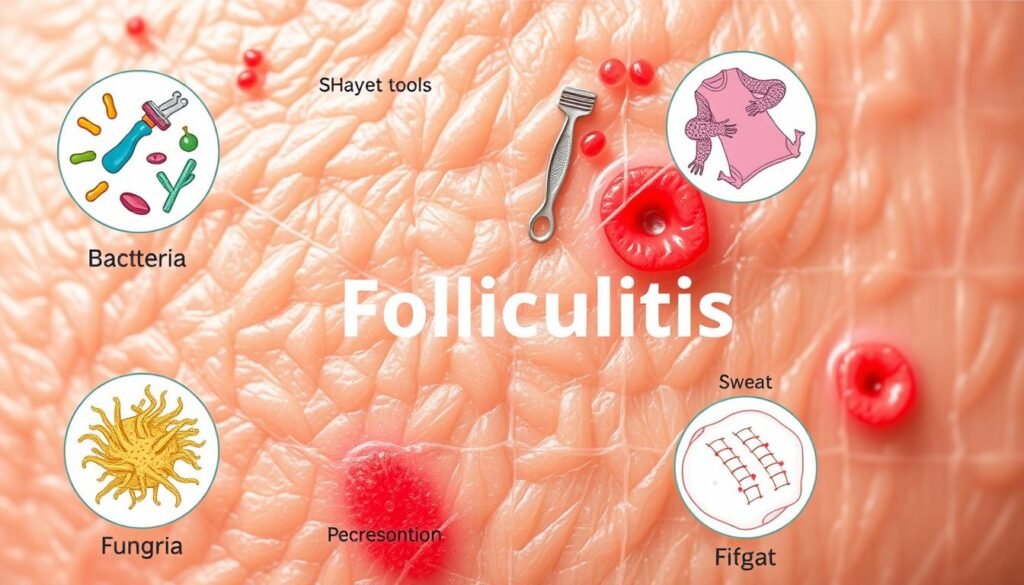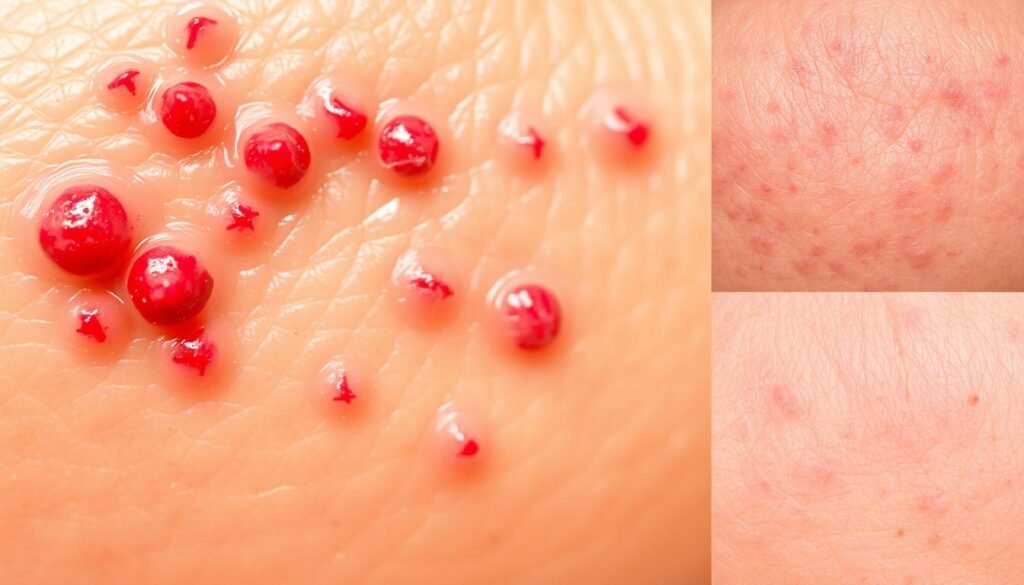About half of all dermatology visits are because of skin issues like folliculitis. This fact highlights how key it is to correctly identify folliculitis for effective treatment. Knowing how to tell folliculitis apart from other skin conditions is critical. Wrong diagnoses can lead to the wrong treatments, making things worse for patients.
This article sheds light on various folliculitis types, what causes them, their symptoms, and how to treat them. Spotting folliculitis early can help manage it better and improve patient health. Through clinical guidelines and dermatological research, this piece shows why getting the diagnosis right is essential in fighting this widespread skin problem.
Key Takeaways
- Understanding the importance of identifying folliculitis early.
- Recognizing common misdiagnoses associated with folliculitis.
- Learning about the various types of folliculitis and their specific characteristics.
- Exploring effective treatment options tailored to different forms of folliculitis.
- Leveraging clinical guidelines for accurate diagnosis.
Understanding Folliculitis
Folliculitis is a widespread but often misunderstood skin issue. It happens due to irritated or infected hair follicles. Knowing about folliculitis helps people recognize its forms. These can be minor irritations or serious conditions needing a doctor’s care.
What is Folliculitis?
This health problem causes hair follicle inflammation. It looks like red bumps or pus-filled blisters. Factors like bacterial or fungal infections can cause it. Shaving, friction, or tight clothing can also lead to folliculitis. Knowing how to spot it is key to manage it properly. It’s often confused with acne or eczema.
Common Symptoms of Folliculitis
The common symptoms of folliculitis include:
- Redness around the affected follicles
- Swelling and tenderness
- Pus-filled bumps that may drain and crust over
- Itching or burning sensations
These symptoms can look like other skin problems. That’s why getting the right diagnosis is crucial. Recognizing these signs helps tell folliculitis apart from other issues. This helps in finding the right treatment.
Causes of Folliculitis
Folliculitis comes from different sources, leading to unique skin reactions. Knowing these causes is key to finding the right treatment. It mainly stems from bacterial, viral, and fungal infections. Each type contributes to different folliculitis forms.
Bacterial Infections Leading to Folliculitis
Staphylococcus aureus, a common skin bacterium, mainly causes bacterial folliculitis. This bacteria gets into hair follicles, causing red, pus-filled bumps. Warm, moist places and weak immune systems increase the risk of getting infected.
Viral Causes of Folliculitis
Viral folliculitis can happen with herpes simplex infections. This virus leads to painful, blistering sores around hair follicles. Knowing about viral causes helps get proper treatment quickly, avoiding worse problems.
Fungal Factors in Folliculitis
The Malassezia genus often causes fungal folliculitis. Humid conditions or too much oil on the skin can encourage fungus growth, causing inflammation. Spotting fungal infections early helps manage symptoms effectively.

| Type of Folliculitis | Common Pathogen | Symptoms | Risk Factors |
|---|---|---|---|
| Bacterial Folliculitis | Staphylococcus aureus | Pus-filled bumps, redness | Warm, humid environments; weakened immune system |
| Viral Folliculitis | Herpes simplex | Painful blisters | Direct contact with infected individuals |
| Fungal Folliculitis | Malassezia | Itchy, inflamed pimples | Oily skin, humid conditions |
Differentiating Folliculitis: Types of Folliculitis
Folliculitis comes in different forms, each unique in its way. It’s important to know these types to spot symptoms and choose the best treatment. In this part, we look at three main kinds: bacterial, viral, and fungal. Each has specific traits that make them stand out.
Bacterial Folliculitis Characteristics
Bacterial folliculitis shows up as pustules that look like acne. These can turn crusty and pop up anywhere, though they’re often seen on the face, neck, and scalp. Staphylococcus aureus bacteria is usually the cause. People with this condition might feel tenderness and swelling around hair follicles, which can itch. Catching it early is key to getting better.
Viral Folliculitis Overview
Viral folliculitis comes with small, fluid-filled blisters and lots of itching. Herpes simplex virus is a common cause. Besides itching, there might be a burning feeling. How bad these symptoms get can change, depending on how strong someone’s immune system is. It’s important to find this early since antiviral medicine might be needed.
Fungal Folliculitis Explained
Fungal folliculitis looks like itchy, red patches around hair follicles. It’s usually because of too much yeast, especially Malassezia, and happens in oily parts of the skin. There might be inflammation and discomfort too. Spotting these signs is the first step toward getting the right antifungal treatment, which is vital for feeling better and stopping it from coming back.
| Type of Folliculitis | Characteristics | Common Causes | Treatment Options |
|---|---|---|---|
| Bacterial Folliculitis | Pustules, crusting, tenderness | Staphylococcus aureus | Topical antibiotics |
| Viral Folliculitis | Blisters, itching, burning | Herpes simplex virus | Antiviral medications |
| Fungal Folliculitis | Itchy red patches | Malassezia yeast | Topical antifungals |

Pseudofolliculitis Barbae: A Special Case
Pseudofolliculitis barbae affects many, especially those with curly hair. It comes from shaving wrong, causing painful bumps. Knowing and spotting this condition is key to handle it right.
Understanding Pseudofolliculitis Barbae
This condition means inflamed hair follicles, mostly from shaving. Bumps form when hair curls back into the skin, causing irritation. It looks like red lesions, sometimes with pus. Spotting these signs helps in getting the right treatment. For more details on recognizing this issue, check out this article.
Treatment Options
There are ways to manage pseudofolliculitis barbae. Start by changing how you shave. A single-blade razor works better and irritates less than multi-blade ones. Also, creams with salicylic acid or corticosteroids ease inflammation.
Preventing razor bumps is crucial too. Regular skin exfoliation and loose clothing help. These steps improve skin health and lower flare-up chances.

Identifying Hot Tub Folliculitis
Hot tub folliculitis is a skin issue linked to unclean hot tub water. It’s mainly caused by the bacteria Pseudomonas aeruginosa. This bacteria loves warm, damp spots. Knowing about its causes and symptoms helps in preventing and treating it.
Causes and Symptoms
The bacteria in unclean water causes hot tub folliculitis. Symptoms include itchy, red bumps where swimwear touches the skin. Also, expect:
- Clusters of small, painful pustules
- Localized swelling and redness
- Discomfort that ends on its own unless more infections occur
Spotting these signs early helps with quick treatment. For more details, check out a guide on hot tub folliculitis.
Preventative Measures
To prevent hot tub folliculitis, keep communal baths clean. This includes several key steps:
- Testing and balancing the water
- Cleaning the tub surfaces
- Showering before getting in
- Covering the tubs when not used
Following water safety rules greatly lowers the chance of spreading the bacteria. These steps help keep everyone safe from hot tub folliculitis.
What is Pityrosporum Folliculitis?
Pityrosporum folliculitis is a skin condition linked to the yeast Malassezia. This issue happens mainly because of too much yeast growth on oily skin. It’s important to know why it happens to treat and manage it right.
Underlying Causes
Oily skin is a perfect place for this yeast to grow. This leads to skin irritation and inflammation. Changes in hormones, like during puberty or periods, can make things worse. Acne can also raise the risk because oily skin is more prone to fungal infections.
Studies show that a good skincare routine can greatly lower the chances of getting this condition. Taking care of the skin in the right way makes a big difference.
Recognizing Symptoms
It’s key to know the symptoms of pityrosporum folliculitis early for proper treatment. This condition usually shows up as itchy, inflamed bumps. They are often found on the chest or upper arms. These bumps can look like acne, which makes it hard to tell them apart.
Looking into dermatology resources can help tell this condition from others. If symptoms keep up, getting professional help is a good idea. For more information on skin matters and how biotin affects health and energy levels, reputable sources are available.
Folliculitis Decalvans: Signs and Symptoms
Folliculitis decalvans is a rare yet severe condition that affects people deeply. Knowing the signs early is key to control it. It leads to scarring hair loss, so recognizing symptoms is vital.
Progressive Nature of Folliculitis Decalvans
This folliculitis type worsens slowly, starting with hair clusters from enlarged follicles. Affected areas might feel itchy or tender. This can cause more issues.
By examining the condition, doctors can tell it apart from others. The change in how one looks can also cause emotional stress.
Treatment Strategies
Each person needs a different plan to treat folliculitis decalvans. Options include:
- Topical treatments reduce inflammation and manage symptoms.
- Systemic medications can halt the condition’s progress.
- Supportive care helps improve patient’s well-being.
Knowing the role of biotin in hair health is crucial. It’s part of an effective treatment plan. Learn more about biotin’s impact here.
New research offers hope for better treatment strategies against folliculitis decalvans. As science advances, achieving good results for patients looks promising.
Insights into Folliculitis Keloidalis
Folliculitis keloidalis causes keloids where hair follicles get inflamed, mostly at the neck’s nape. To diagnose it, look for itchy and painful bumps that get worse over time. Also, knowing if there was any past injury helps a lot.
Identifying Folliculitis Keloidalis
It makes keloids more than other folliculitis types. Doctors need to know your specific symptoms to diagnose you right. They also check to make sure it’s not something else that looks similar.
Managing Symptoms
Treating this condition needs a mix of medical and surgery options based on what the patient needs. Doctors may remove keloids or use steroid shots to lessen symptoms and aid healing. With these treatments, many patients see a big improvement.
